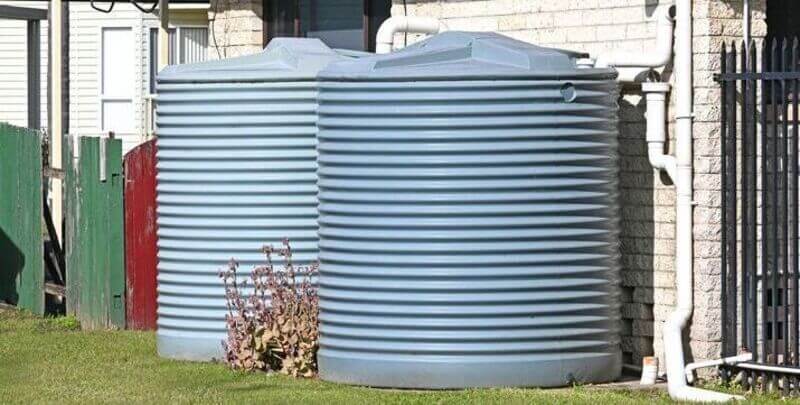
How Do Rainwater Tanks Work?
Rainwater tanks are pivotal in sustainable water management systems, serving as reservoirs and tanks for collected rainwater.
These storage tanks enable households, businesses and communities to harness nature’s bounty for various purposes, thereby reducing reliance on traditional water sources and promoting environmental sustainability.
Understanding the intricate workings of rainwater tanks is paramount to maximising their benefits and fostering water conservation efforts.
The Components of a Rainwater Harvesting System
A comprehensive rainwater supply filtration system (or water harvesting system) comprises an array of essential components meticulously designed to facilitate the efficient collection, filtration and storage of rainwater:
- Roof catchment area: The expansive surface of roofs where rainwater is naturally collected.
- Gutters and downpipes: Conduits that precisely guide rainwater from the roof to the storage tank.
- Leaf guards and filters: Mechanisms installed to screen out leaves, debris and other contaminants, safeguarding the purity of collected water.
- First flush diverters: Devices strategically positioned to divert initial runoff, which may contain pollutants and sediment, away from the storage tank.
- Storage tank: A robust container capable of accommodating vast volumes of rainwater, available in diverse sizes and materials to suit specific needs.
- Overflow system: A critical safety feature that ensures excess water is efficiently redirected away from the tank during heavy rainfall, preventing potential damage or overflow.
- Pump and distribution system: Mechanisms responsible for the seamless transfer of water from the storage tank to designated usage points, offering unparalleled convenience and accessibility.
The Process of Collecting Rainwater
The process of the system of pipes collecting rainwater unfolds with systematic precision, adhering to a series of meticulously orchestrated steps:
- Rainfall: Nature’s gift descends upon the roof catchment area as rain, initiating the collection process.
- Gutter and downpipe network: A network of gutters and downpipes swiftly channels rainwater from the roof to the awaiting storage tank below, minimising wastage and maximising efficiency.
- Filtration: Leaf guards and filters diligently sift through the cascading rain, meticulously removing leaves, debris, and impurities to maintain the pristine quality of the collected water.
- First flush diverter: A crucial component strategically intercepts the initial runoff, diverting it from the storage tank to prevent contamination and preserve water purity.
- Storage: The harvested rainwater finds refuge within the confines of the storage tank, patiently awaiting deployment during periods of drought or water scarcity.

Using Collected Rainwater
The versatility of rainwater knows no bounds, with myriad applications spanning diverse domains:
- Irrigation: An invaluable resource for nurturing flourishing gardens, lush lawns and thriving agricultural endeavours.
- Toilet flushing: A sustainable alternative to potable water, rainwater lends itself admirably to the task of toilet flushing, conserving precious resources with each flush.
- Outdoor cleaning: Vehicles, sidewalks, and outdoor surfaces bask in the cleansing embrace of rainwater, minimising water consumption while maximising cleanliness.
- Household chores: From watering indoor plants to mopping floors, rainwater serves as a steadfast ally in tackling a myriad of domestic chores with unparalleled efficacy.
Maintenance and Care of Rainwater Tanks
The longevity and efficiency of the water flow of good tanks and tank, rainwater tanks hinge upon diligent good tanks and rainwater tank work, maintenance and meticulous care of the water tank:
- Cleaning: Regularly purge gutters, filters, and first flush diverters of debris and detritus to prevent clogs and preserve water quality.
- Inspection: Routinely scrutinise the tank for signs of leaks, cracks or damage, promptly remedying any issues to mitigate water loss and maintain structural integrity.
- Water treatment: Consider treating stored water as needed to uphold stringent quality standards and ensure its suitability for intended uses.
- Seasonal preparations: In colder climates, take proactive measures to winterise the system, shielding it from the ravages of frost and freezing temperatures to avert potential damage.
The Importance of Rainwater Tanks
Rainwater tanks play a crucial role in sustainable water management and offer various environmental, economic, and social benefits.
Here are some key points highlighting the importance of rainwater tanks:
- Water conservation: Rainwater tanks collect and store rainwater, reducing reliance on traditional water sources like municipal supplies or underground aquifers. They help conserve water resources by capturing and utilising rainwater for various purposes.
- Reduce strain on water systems: Using rainwater for non-potable purposes such as irrigation, flushing toilets, or washing cars reduces the demand on local water treatment plants and distribution systems.
- Mitigation of urban runoff: Rainwater tanks can help manage stormwater runoff by capturing rain before it runs off into streets and the stormwater drainage system or drains. This reduces the risk of flooding and minimises soil erosion.
- Drought resilience: Rainwater tanks provide rainwater runoff as a backup water supply during droughts or water restrictions, helping communities and individuals maintain essential water usage.
- Promotion of sustainable practices: Installing rainwater tanks encourages individuals and businesses to collect rainwater and adopt sustainable water practices, promoting a broader awareness of environmental stewardship.
- Eco-friendly construction: Integrating rainwater harvesting into building design is a sustainable construction practice, contributing to green building certifications and lowering the environmental impact of structures.
- Support for agriculture: Rainwater harvesting is vital for agriculture, especially in areas with irregular rainfall. It provides an additional water source for crops, livestock, and irrigation, contributing to food security.
- Groundwater recharge: When rainwater is collected and stored in tanks instead of being allowed to run off, it can slowly percolate into the ground, contributing to the recharge of groundwater aquifers.
- Community resilience: Rainwater tanks contribute to community resilience by harvesting rain and ensuring a local, decentralised water supply. This becomes especially crucial in times of emergencies or natural disasters.
- Environmental impact: Reduced reliance on traditional water sources (mains water) can lessen the environmental impact associated with water extraction, treatment, and distribution, ultimately promoting more sustainable water use.
In summary, rainwater tanks play a vital role in sustainable water management, providing multiple benefits ranging from water conservation and cost savings to environmental protection and community resilience.

Harnessing Nature’s Gift
In summation, rainwater tanks can stand as stalwart sentinels of sustainability, embodying the essence and best value of responsible water management and environmental stewardship.
Individuals and communities can chart a course towards a future defined by abundance, resilience, and ecological harmony by delving into the intricacies of rainwater tanks and embracing conscientious maintenance practices for water tanks.
Let us harness the transformative power of rainwater tanks and tanks to forge a path towards a greener, more sustainable tomorrow, where the precious gift of water flows freely, and our water tanks and tank conservation legacy endures for generations to come.
Please note: This information is provided for advice purposes only. Regulations differ from state to state, so please consult your local authorities or an industry professional before proceeding with any work. See our Terms & Conditions here.